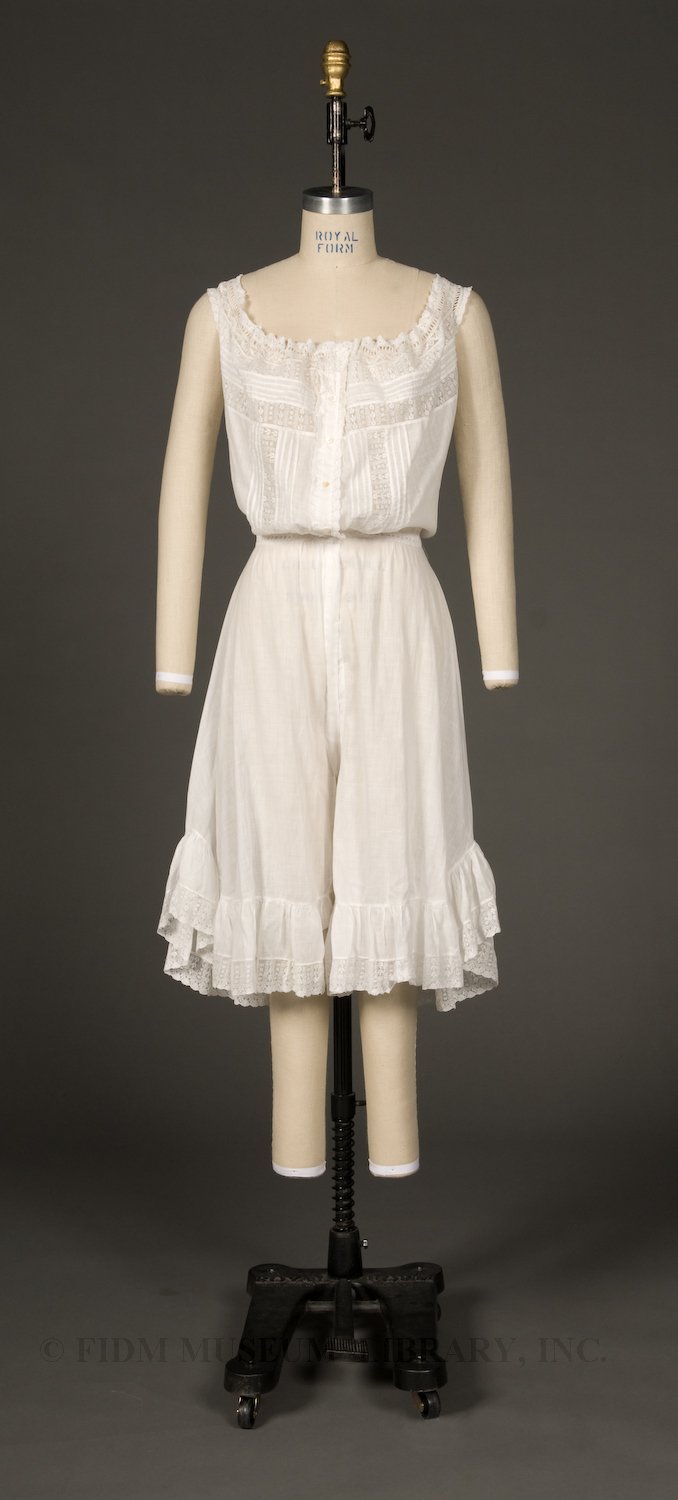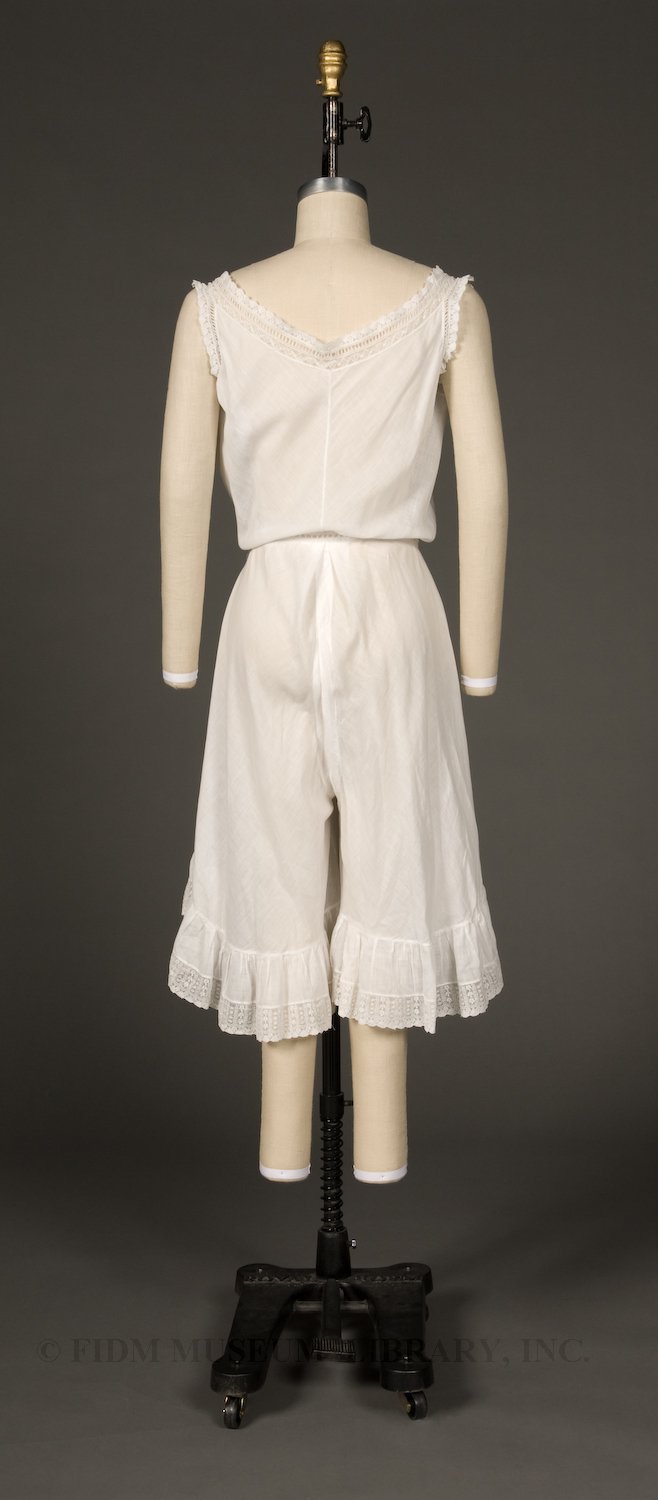Combination undergarments, which combined chemise and drawers into one garment, first appeared in the late 1860s or early 1870s. By the 1890s, combinations had largely replaced the long chemise worn over a separate pair of drawers. The advantage of the all-in-one combination undergarment was its relative lack of bulk. Drawers had a gathered drawstring waist and when worn under a loose chemise, petticoat(s), corset and dress, they created an unnecessary layer of bulky, gathered fabric at the waist. A 1905 advertisement for the Leona combination undergarment sings the praise of combinations in general, and the Leona in particular, declaring "Leona leaves no fullness, puckers or bunches at the waist or hips."1
 Combination undergarment
Combination undergarment
Cotton
1900-1910
Gift of California Hospital Medical Center
S2007.165.1
In the 19th century, combinations were usually made of extremely fine, lightweight cotton fabrics like lawn, batiste, or muslin. In the early years of the 20th century, they were often made of silk. Even though a combination was the foundation layer, and therefore not meant to be seen, they were often decorated with lace or embroidery. The combination pictured above features machine lace inserts at bodice and hem, along with delicate bodice pintucks. The low, rounded neckline can be individually sized through tightening or loosening the neckline ribbon, which is inserted through small slits. Though the waistband is obscured by the bloused bodice, it is made of eyelet-type lace, also with slits for an inserted ribbon. The center front button closure seen here is typical of combination undergarments of the 19th century; in the 20th century, the closure was more often on the back of the garment.
Fashion scholars have noted that combination undergarments became widely popular in the 1880s, the same era that dress reformers were promoting their views on women's dress. Based on the premise that women's dress was irrational, unhealthy and unsanitary, dress reformers advocated for a variety of changes, including the abolition of corsets, a reduction in the layers of undergarments worn and the adoption of bifurcated garments by women. As advocated by dress reformers, the combination was usually made of wool knit. Though the combination undergarment pictured above is by no means a reform undergarment, it is evidence of the ways in which ideas related to rational dress seeped into fashion.
Combination undergarments were adopted by sporting women, who favored long-sleeved, high-neck, combinations when hiking or bicycling outdoors in fall or winter. These were sometimes made of soft flannel or calico, but more often of knitted wool. When worn under a skirt or dress, the combination provided an additional layer of warmth, while the inherent stretch of a knit combination allowed for more freedom of movement. A knitted combination undergarment was very similar to the undergarments worn by men in the late 19th century. Known today as a union suit, it presents a rare instance of men and women wearing a nearly identical undergarment.
 Combination undergarment
Combination undergarment
Cotton
1910-12
Gift of Mrs. Roxanne Wilson
S2003.1.12
The combination undergarment pictured above demonstrates the way in which undergarments became increasingly short and fitted to the body in the 20th century. Compared to the 1900-1910 combination undergarment pictured above, the 1910-12 version is positively racy! Not only is it shorter and more fitted, the numerous lace inserts both suggest and obscure the body underneath. Though combinations were worn into the 1920s, they had to compete with an increasing variety of undergarments, including the newly introduced brassiere. By the 1930s, combinations were worn primarily for warmth, not as an undergarment in itself.
1 Probert, Christina. Lingerie in Vogue Since 1910. New York: Abbeville Press. 1981.: 15.



So that is what Amelia Peabody is referring to in the novels featuring that character!
Haha! That’s just the reason I looked this up!!
Excellent information here!
So, I’ve seen instances of petticoats and corsets from 1860s on in a variety of colors, but I have not seen chemises (regular or combination), drawers, or camisoles in colors … only in whites and ivories. Were those particular underpinnings also made in colors (black, even?) in the late 19th century?
Thank you in advance~
Hello MrsCMJ! Thank you for your question. Yes, black could have been used in chemises, drawers, or camisoles in the late-19th century for mourning; white garments could also be threaded through with black, grey, or mauve ribbon depending on the level of mourning. The more colorful or decorated examples of underpinnings – often made of silk – would have been found in the luxury market that did not require repetitive cleaning. The FIDM Museum has a British mid-1860s white cotton chemise and drawers set with contrasting red trim.
Fantastic, thank you! Would love to visit this museum sometime soon!
Absolutely gorgeous. But wouldn’t the looseness of the bodice be uncomfortable under a corset?
I have to ask. When wearing a combination, was there any way of using a toilet (or a chamber pot) without getting completely undressed?
@mia
they have a slit in the middle, so they dobt have to take anything off.
Mia, at least in the 1800s, the crotch seam was left unsewn, so women could simply move the crotch panel aside when they went to the bathroom.
I have a question of my own. In Agnes Walker’s Manual of Needlework is a pattern for combinations. There are only two pattern pieces and no indication of where the waistband might sit or how it was to be attached. Other garments had curved waistbands, so would the ribbon also have been curved? I am also a bit curious about the ruffles at the ends of the legs. Were these ubiquitous or something a busy working women might omit? Were they always made of lace or would the same fabric gathered suffice? Thank you!
Hi Chloe – if we’re understanding your question correctly, the waistband can be just a straight piece of cloth that goes around the natural waist. As for the ruffles: some had them, some didn’t. It depended on how fancy or plain one wanted or could afford their underwear. Lower classes used stouter linen and cotton, upper class women finer materials often with lace and embroidery.
In Barbara Pym’s novel “Some Tame Gazelle “ the new curate wore combinations. Were there men’s’ versions?
Combinations were only intended for women–we don’t think there’s a man’s version. Thanks for reading!
There were combination men’s undergarments that joined the undershirt with the drawers. It was popular not only for its warmth but for cutting down on bulky fabric around the waist. See The Story of Men’s Underwear, Shaun Cole, pp. 62-66.